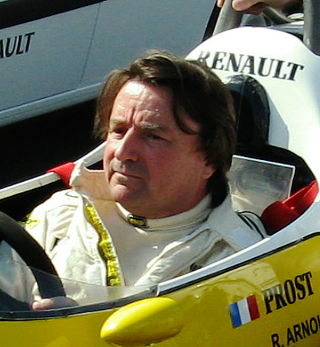
René Alexandre Arnoux is a French former racing driver who competed in 12 Formula One seasons. He participated in 165 World Championship Grands Prix winning seven of them, achieving 22 podium finishes and scoring 181 career points. His best finish in the World Drivers' Championship was third in 1983 for Ferrari. In 1977, Arnoux won the European Formula Two Championship. In 2006 he raced in the inaugural season of the Grand Prix Masters series for retired F1 drivers.
ATS is an Italian automotive constructor. It once had a racing team that operated between 1963 and 1965, formed after the famous "Palace Revolution" at Ferrari.

The 1952 French Grand Prix was a Formula Two race held on 6 July 1952 at Rouen-Les-Essarts. It was race 4 of 8 in the 1952 World Championship of Drivers, in which each Grand Prix was run to Formula Two rules rather than the Formula One regulations normally used. Unusually this race was run over a duration of 3 hours, rather than a fixed distance.

The 1952 Italian Grand Prix was a Formula Two race held on 7 September 1952 at Monza. It was the eighth and final round of the 1952 World Championship of Drivers, in which each Grand Prix was run to Formula Two rules rather than the Formula One regulations normally used. The 80-lap race was won by Ferrari driver Alberto Ascari after he started from pole position. José Froilán González finished second for the Maserati team and Ascari's teammate Luigi Villoresi came in third.

The 1953 Dutch Grand Prix was a Formula Two race held on 7 June 1953 at the Circuit Zandvoort. It was race 3 of 9 in the 1953 World Championship of Drivers, which was run to Formula Two rules in 1952 and 1953, rather than the Formula One regulations normally used. The 90-lap race was won by Ferrari driver Alberto Ascari after he started from pole position. His teammate Nino Farina finished second and Maserati drivers José Froilán González and Felice Bonetto came in third

The 1953 Belgian Grand Prix was a Formula Two race held on 21 June 1953 at Circuit de Spa-Francorchamps. It was race 4 of 9 in the 1953 World Championship of Drivers, which was run to Formula Two rules in 1952 and 1953, rather than the Formula One regulations normally used. The 36-lap race was won by Ferrari driver Alberto Ascari after he started from second position. His teammate Luigi Villoresi finished second and Maserati driver Onofre Marimón came in third.

The 1954 Spanish Grand Prix was a Formula One motor race held on 24 October 1954 at Pedralbes. It was the ninth and final race in the 1954 World Championship of Drivers. The 80-lap race was won by Ferrari driver Mike Hawthorn after he started from third position. Luigi Musso finished second for the Maserati team and Mercedes driver Juan Manuel Fangio came in third.

The 1955 Monaco Grand Prix was a Formula One motor race held at Monaco on 22 May 1955. It was race 2 of 7 in the 1955 World Championship of Drivers and was given an honorary name, Grand Prix d'Europe. The 100-lap race was won by Ferrari driver Maurice Trintignant after he started from ninth position. Eugenio Castellotti finished second for the Lancia team and Maserati drivers Jean Behra and Cesare Perdisa came in third.

The 1959 German Grand Prix was a Formula One motor race held at the Automobil-Verkehrs- und Übungs-Straße in West Berlin on 2 August 1959. It was race 6 of 9 in the 1959 World Championship of Drivers and race 5 of 8 in the 1959 International Cup for Formula One Manufacturers. It was the 21st German Grand Prix and was only the second time the race was not held at the Nürburgring. AVUS had previously held the original German Grand Prix in 1926. The race was held over two 30 lap heats of the eight kilometre circuit for a total race distance of 498 kilometres.

The 1962 French Grand Prix was a Formula One motor race held at Rouen-Les-Essarts on 8 July 1962. It was race 4 of 9 in both the 1962 World Championship of Drivers and the 1962 International Cup for Formula One Manufacturers. The race was won by Dan Gurney, his first Formula One victory, driving a Porsche, that company's only win as a constructor in a Formula One championship race coming after three years of racing. It was the third time that the French Grand Prix was held at Rouen, the previous time being 1957.

Eugenio Castellotti was a racing driver from Italy. He won the 1956 Mille Miglia and 1956 12 Hours of Sebring, and took several Formula One World Championship podiums. His career was cut short by a fatal testing accident at Modena in 1957. He was nicknamed "Il Bello".
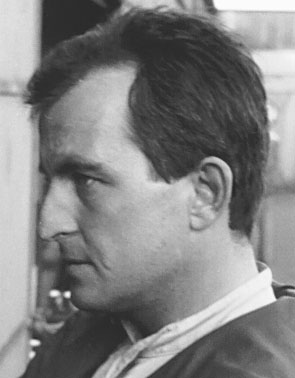
Ludovico Scarfiotti was a Formula One and sports car driver from Italy. Just prior to entering Formula One, he won the 1963 24 Hours of Le Mans for Ferrari. He later participated in 12 World Championship Formula One grands prix, and many non-championship races. He won one World Championship race, and scored a total of 17 championship points. A motor sports competitor for a decade, Scarfiotti won the 1962 and 1965 European Hillclimb Championship. He was proclaimed Italy's best driver in both 1962 and 1965.
Bellasi is a Swiss-Italian motorsport company specialized in manufacturing composite parts for racing cars. From 1970 to 1971 it was a Formula One constructor. They participated in six grands prix, entering a total of six cars.

Count Giovanni Volpi di Misurata is an Italian-Algerian nobleman and a former automobile racing manager and Formula One team owner. He inherited a fortune, at the age of 24, from his father, Count Giuseppe Volpi di Misurata, a politician financier and founder of the renowned Venice Film Festival. During World War II, Giovanni Volpi's father served in Benito Mussolini's cabinet as the minister of Finance and one of his chief advisors. He designed several of Mussolini's austerity measures and escaped prosecution after the war. His father also acquired and restored Villa Barbaro at Maser, Italy, built originally for the Barbaro family. Giovanni Volpi is the son of Giuseppe and his second wife, Nathalie El Kanoni.
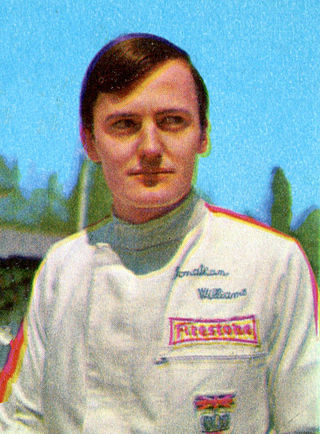
Jonathan James Williams was a British racing driver.

The Ferrari 500 was a Formula 2 racing car designed by Aurelio Lampredi and used by Ferrari in 1952 and 1953, when the World Championship was run to F2 regulations.
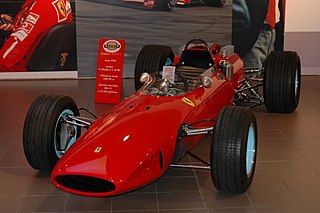
The Ferrari 158 was a Formula One racing car made by Ferrari in 1964 as a successor to the V6-powered Ferrari 156 F1.
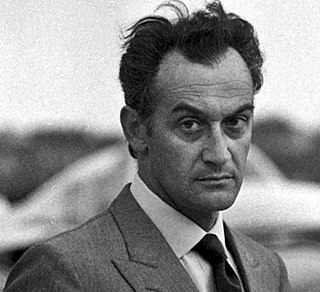
Alejandro de Tomaso was a racing driver and businessman from Argentina. His name is sometimes seen in an Italianised form as Alessandro de Tomaso. He participated in two Formula One World Championship Grands Prix, debuting on 13 January 1957. He scored no championship points. He later founded the Italian sports car company De Tomaso Automobili in 1959.
The Ferrari 246 F1-66 was a racing car used by Scuderia Ferrari and Reg Parnell Racing during the 1966 Formula One season.

The Penske PC1 was a Formula One racing car developed and raced by Penske Racing during the 1974 and 1975 Formula One seasons. The car was designed by Geoff Ferris, and was raced by drivers Mark Donohue and John Watson. The PC1 entered and competed in 12 Grands Prix, and was replaced by the Penske PC3 in the 1976 season.


















